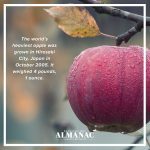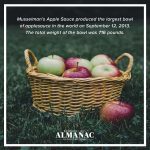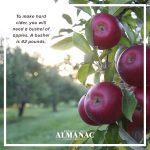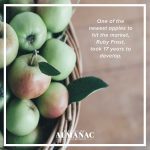Josh Kilmer-Purcell's Blog, page 3
October 11, 2018
How Cider and Doughnuts Became the Perfect Pair

One of the best parts of going apple picking is having a fresh cider doughnut at the end of the day. Luckily, we have a few orchards within an hour’s drive from the farm, meaning that we have a lot of chances to get an apple cider doughnut beyond our annual apple-picking pilgrimage.
Our last trip home from apple picking got us thinking, how did farmers start selling apple cider doughnuts? Who knew that fresh doughnuts and hot cider were such a perfect pair?
It all comes down to a man named Adolph Levitt and his magic machine. But first, a quick primer on why cider and doughnuts are even around in the first place.
Cider, especially the alcoholic kind, has been around for a long time. In colonial days, most people drank hard cider instead of water because you could guarantee that the cider was safe to drink. A common misconception of cider is that it was created with old apples from the end of harvest when really cider was created as a way to use apples that were not truly edible.

Crabapples, which are the only apple variety that is native to the United States, are basically inedible. They are tough, tart and tiny. But for what they lack in eat-ability, they make up for in drinkability. When crabapples are pressed, you’re able to extract the tannin-filled juices and create some pretty complex libations. Other apple varieties traditionally grown in orchards around America are good for adding different colors and tasting notes to cider, but you don’t need as many of these “good” apples to make really good cider.
Pair this with the growing mentality most consumers had for the majority of the 20th century— produce needed to look pretty for us to buy it (a topic we explore a bit more here). What you get is something that ends up making farmers more money: farmers grow a variety of apples, crabapples become the base for cider and any ‘ugly’ apples can be used to give the cider color and additional flavors. This leads to farmers wasting less of their harvest while giving them another product to sell at their farm stands.

This is where Adolph Levitt comes in. He was the inventor of the original doughnut-making machine. These machines were able to cut out perfectly-sized doughnuts, plop them into oil to fry and then flip the doughnuts out and into your topping of choice. When Levitt first brought these machines to the marketplace, people went nuts over them. Not only did it make life easier for bakery owners, but it was also mesmerizing to watch.
With the rise of car culture, more and more farm stands and markets were looking for ways to get drivers to pull over and shop. Levitt saw his doughnut machine as the perfect solution, and for many farmers, it was. Levitt began selling his doughnut machines to farm stands and orchards up and down the east coast.
We don’t know who came up with the first apple cider doughnut recipes, but we do know where American doughnut recipes came from. Danish immigrants brought their version of doughnuts, olykoeks (which translates to “oily cakes”) and the French brought their version named pets-de-nonne (which translates to “nun’s farts.” Yes, really.) All we know is that doughnut machines were usually sold with a plain, industrial mix and farmers were eager to tweak the recipes.

Soon farmers were opening up their orchards to the growing amount of weekend drivers. Drivers would be lured in with the doughnut machines making apple cider doughnuts fresh to order. A cup of apple cider (hot or cold) and fresh hot doughnut could lead to more purchases, like pies, ice cream and jellies. Or it could lead them to stay at the farm for the day, picking their own apples. Even if apple crops had a poor year, farmers could still have money coming in from their apple-related products and the rise of agritourism.
At the end of the day, we know why cider and doughnuts a good pair. Sweet, tart cider balances the oiliness of a cake doughnut. But what makes them a great pair is how these treats help orchards stay in business, providing us with food and fun for years to come.

1
Spring 2017 Almanac

2
Summer 2017 Almanac

3
Autumn 2017 Almanac

4
Winter 2017 Almanac
Visit the Mercantile
The post How Cider and Doughnuts Became the Perfect Pair appeared first on Beekman 1802.
September 21, 2018
Tips for Better Sleep from Two Terrible Sleepers

Of all the different things that Dr. Brent has taught our Neighbors about, a guide on how to sleep better has never been one of them. The closest we’ve come is instructing you on how to take a good nap. But if we pull back the curtain a bit, we can show you why we aren’t the best sleep educators.
We’re terrible sleepers.
Well, maybe not terrible. But we’re not very good at it. Brent doesn’t know how to sleep in. The only time he’s been asleep past 7am was due to a horrible bought of jetlag. Josh, on the other hand, can sleep in easily, but he also habitually wakes up at 2 am. And this isn’t that wake-up, adjust, and fall back asleep type of disruption. This is a wake-up, think about everything in the universe, maybe even pace a little, and fall back to sleep in about an hour and half kind of wake up.
However, after years of sleeping in hotels, different time zones, and in strange places (there’s no shame in taking a barn nap between chores), we’ve come up with what we think is the perfect recipe for a good night’s sleep. Do we follow all of these steps all of the time? No, it’s not really possible, but we try our best. So, hopefully, you will do as we say, and not as we do.

Turn down that pesky blue light
We are the biggest offenders of using our phones or laptops late into the evening. Our electronic devices emit a lot of blue light, which disrupts the natural flow of serotonin in the body. This means that using your phone before bed or even in bed will mess with your ability to sleep well. The best advice is to stop using phones, laptops and tablets at least an hour before you plan to head to bed. However, if you are like us, you might not be consistent at putting your phone down. So if you’re not going to follow this rule, at least cheat a bit by using apps like F.Lux or enabling Night Mode (if you’re an Android user) or Night Shift (if you’re an Apple user). These apps help your body get ready for sleep by applying a yellow filter to your screen. This cancels out some of the blue light, helping you sleep better later on.
Get your bedroom ready for sleep
Did you know that autumn is the best season for sleeping? It’s because the days are getting shorter and the sun is on a schedule more in-sync with our body’s circadian rhythm. In addition, the temperature at night is ideal for sleeping (averaging between 57-65 degrees Fahrenheit.) When it’s not autumn, there are ways you can mimic that perfect sleep atmosphere. During sunnier seasons, trying shutting curtains and dimming the lights around the house starting around 7 pm and adjust your bedroom’s temperature until it hits that 57-65-degree sweet spot. The combination of dimmed light and cooler temps will signal your brain to start getting into sleep mode.

Keep a journal near your bed
Brent keeps a journal with him at all times. He loves to have a sleek notepad with a protective cover to jot down ideas, notes or things that inspire him. Keeping a journal or something to write on near your bed is great if you are someone who has a hard time falling or staying asleep. If you’re too stressed out to sleep, write down what thoughts are racing through your head in the journal. Have a great idea right as you close your eyes? Write it down so you can revisit it in the morning. Bored, can’t sleep, and want to scroll mindlessly through your phone? Don’t! Are you even reading this blog post? Put down the phone, pick up the journal. You don’t even need to write in it, doodling is just as good. A notepad near your bed helps you empty your brain so that it’s all ready for sleep.
Tell yourself that you won’t fall asleep
You know how toddlers will say they aren’t tired, but will quickly fall asleep once they lay down? There’s actually science behind this beyond “the terrible twos.” It’s called a sleep paradox. The way you can try it as an adult Is by lying in bed with either your eyes tightly shut or very wide open (this exaggerated action is part of the process). Repeat to yourself “I am not falling asleep” and you will notice that after a few minutes, you’ll start drifting off. This happens because our brains don’t respond well to negative commands and it will naturally want to rebel. So go ahead and act like a toddler. Scrunch up your face and tell yourself that you aren’t going to fall asleep. Just make sure you’re laying down for it to work, otherwise you’ll just look like a very grumpy adult.
Do you have any sleep tips to share with us? What do you do to make your bedroom more sleep-friendly? Let us know. We’ll be here, trying very hard not to scroll through Instagram at 11 pm at night. Sweet dreams.

1
Spring 2017 Almanac

2
Summer 2017 Almanac

3
Autumn 2017 Almanac

4
Winter 2017 Almanac
Visit the Mercantile
The post Tips for Better Sleep from Two Terrible Sleepers appeared first on Beekman 1802.
Six Ways Carrots Benefit Every Body

Like many of the foods we eat today, carrots were originally grown for medicinal purposes. Ancient Romans used every part of the plant to heal animal bites and scratches, as a diuretic, and to help new moms recuperate after giving birth. Now we wouldn’t recommend using mashed carrots on a cat scratch, but the Romans were right in believing that carrots have health benefits for your whole body. These simple roots are full of vitamins, minerals and nutrients that can help you (and everyone else in your household) in more ways than one.

1. The benefit everyone knows: Keep your eyes healthy
Carrots contain three different types of carotenoids: alpha-carotene, beta-carotene, and lutein. All three serve different areas of the eye. Alpha-carotene supports vision health and can improve your vision in low-light. Beta-carotene keeps your corneas healthy. Lutein protects your eyes against free radical damage and can help prevent diseases like macular degeneration.
2. Look more youthful
These three carotenoids are antioxidants, which are important for skin health. Antioxidants form a barrier around your skin cells and protect them from free radical damage. They also can reverse existing damage, which is why carotenoids are frequently found in anti-aging products.

3. Pick your color, pick your benefit
Carrots aren’t just orange. These tasty taproots come in a variety of colors, and each color has a unique health benefit. Purple carrots contain anthocyanins. These antioxidants have anti-inflammatory properties and can help prevent heart attacks. Red carrots are full of lycopene, a carotenoid that fights neuropathic pain. Yellow carrots have all the benefits of orange carrots but contain higher levels of lutein.
4. Protect your brain
Another benefit of beta-carotene? It protects your brain from cognitive decline. A Harvard study conducted over 18 years followed men who consumed 50 mg of beta-carotene every other day and men who took a placebo every other day. The men who took the beta-carotene supplements experienced less cognitive delay overall and brain decay onset was much slower compared to those who took the placebo.
5. Lower your blood pressure
The fiber and potassium in carrots are a one-two punch for heart health. One medium carrot has about 2 grams of fiber, and studies show that adults who consumed a diet high in fiber had lower blood pressure overall. A half-cup of chopped carrots contains 205 milligrams of potassium, which helps regulate fluid balance and muscle function. Your heart muscle needs potassium to keep your blood pressure at healthy levels.

6. Feed ‘Em to Fido
Carrots are a perfect natural treat for the canines in your life. Carrots are low calorie and are fiber-full, so you don’t need to feel bad about “spoiling” them with these extra treats. Raw carrots have an added benefit for your dog’s teeth. The crunchy texture is perfect for scraping away plaque. To get all of the nutritional value out of a carrot, make sure to cook them (don’t add any oils or seasonings). Dogs can’t process the Vitamin A in carrots unless they are baked, boiled or steamed.
The post Six Ways Carrots Benefit Every Body appeared first on Beekman 1802.
September 11, 2018
How to Pick the Perfect Pumpkin (And Keep It That Way)

Despite having a robust heirloom vegetable garden, we still have to go out and buy a pumpkin if we want to have sturdy Jack O’ Lanterns. The gourds and squashes that we grow on the farm are definitively in the “eating” category. We harvest Small Sugar and Cushaw Orange pumpkins, which are smaller than what you will find at the store or the pumpkin patch. These are also referred to as “pie pumpkins” and are sweet gourds with flavorful flesh.
If you ever see these types of pumpkins are your local farmer’s market, snatch them up and process them quickly. They are exquisite in a pumpkin pie, roasted slowly in the oven, or even in a cheesecake. But when it comes to decorative pumpkins, we have a few tips on finding the best one.

Give it a thorough inspection
This is one of those rare instances where a pretty appearance indicates high quality. Normally, we encourage people to try produce that’s a little on the ugly side, but if you want a pumpkin that lasts, prettier is better. Run your hands over the pumpkin and press your fingers in occasionally to check for soft spots. These denote areas where the pumpkin has either been injured or is starting to decompose. Check for wart-like growths, cuts or indents in the pumpkin skin. Blemished pumpkin skin means that your pumpkin will have a short shelf- (or porch-) life.
Color is everything
Your pumpkin should be uniformly orange from top to bottom. Check for any spots that are lighter in color, this may indicate frost damage, especially if you are getting your pumpkin towards the end of the season. You also want to avoid pumpkins with green spots (not ready yet) or brown spots (too ripe and starting to rot.) Soft spots that are also discolored mean that the pumpkin has not been handled with care.

Avoid picture-perfect pumpkin patches
Picking fruit right off the vine is a beautiful pastoral image. But when it comes to pumpkins, you want someone to have picked it for you. If pumpkins are still on the vine, it means that they aren’t mature enough yet. Picking them now may make for a great Instagram moment, but your gourd will start decaying quickly. So if you want to have a pumpkin that lasts until October 31st, go for one that is vine-less.

A good stem and a sturdy bottom
Ideally, you’ll want to pick a pumpkin with a flat bottom so that it’s harder to tip over. But we don’t mind a bumpy bottom every once in a while. Tap the bottom of the pumpkin a few times, it should sound hollow. A pumpkin that makes a muffled noise when tapped is past its prime. Tap around the stem of the pumpkin as well.
When it comes to your stem, you want one that is firm to the touch and well attached to the pumpkin. If the stem comes off with little effort, it’s overripe. After inspecting the stem, don’t touch it anymore. Carry your pumpkin in your arms or in a bag. Removing the stem makes pumpkins get mushy faster.
Now that you’ve picked your pumpkin, you’ve carved it and you’ve sorted and roasted your seeds, it’s time to preserve it. If you live in a climate like ours, you might find that your autumn weather isn’t always cool and crisp. Temperature changes, pesky insects and more are all lurking around, looking to take your Jack O’ Lantern from smiling to frowning fast.

Keep your pumpkin looking fresh until Halloween:
1. If the weather in your area is still fairly warm, it’s best to store your pumpkin inside at night. Keep it in a cool, dark place, preferably in the fridge. Cold storage makes pumpkins stay fresher, longer.
2. Scrape as much of the pulp out of your pumpkin that you can— it goes bad faster than the rest of the pumpkin. After carving, remove any extra pieces or pulp that are in the pumpkin. Pat the inside dry with a paper towel, then smear on a thin layer of petroleum jelly. The jelly forms a moisturizing shield that will keep your pumpkin fresh and deter bugs from having a feast.
3. Another way to keep your pumpkin looking good is to give it a dip. After the pumpkin has spent a week carved and outdoors, bring it in to have a long overnight soak. Simply place the pumpkin in a bucket full of cold water and leave until morning. In the morning, take out your pumpkin, dry the skin off and it will be ready for another week on your steps, porch, or wherever you like to show off your fancy pumpkin carving skills.
And don’t forget to show off your carvings this fall! Take a picture of your Jack O’ Lantern and upload it to Facebook or Instagram and tag us. We love to see what our creative Neighbors come up with.

1
Spring 2017 Almanac

2
Summer 2017 Almanac

3
Autumn 2017 Almanac

4
Winter 2017 Almanac
Visit the Mercantile
The post How to Pick the Perfect Pumpkin (And Keep It That Way) appeared first on Beekman 1802.
18(+02) Facts about Apples
At Beekman 1802, we love our apples. We go apple picking every year, and most Neighbors know that we stumbled upon Sharon Springs because we got lost after apple picking in central New York. When it came time to add more apple trees to our farm, we made sure to select varieties that were delicious, but also had rich histories and unique details. Along the way, we’ve learned a lot about apples and their impact on our health, our history and our world. Read on to learn more about this amazing fruit.


















What is an 18(02) post without your bonus 02!


The post 18(+02) Facts about Apples appeared first on Beekman 1802.
Get Scared at the Top 5 Spookiest Graveyards

We’ve covered a lot of spooky, creepy and scary stuff here at Beekman 1802. There’s Mary Beekman, the spooky but delightful ghost that haunts our halls (she thinks we are her imaginary friends.) We have written about the most haunted places to visit and the most famous ghosts (don’t worry, Mary made the list.) We’ve even battled the scary effects of using harmful, chemical-filled cleaners.
After all of these scary stories, we can confidently say that there isn’t much that can scare us. No spooky specters that could rattle our bones. No bumps in the night that give us a fright. Long story short, we ain’t afraid of no ghosts.
But there is one thing that still gives us a little bit of the heebie-jeebies. Graveyards.
Now, during the day, we have no qualms about graveyards. They are wonderful ways to honor those who have passed and to learn more about the area we live in. But at night, when it’s dark, the sky is cloudy, and the wind is blowing, we can’t help but be a little creeped out.
Before we learned more, we always thought the crypt and former graveyard on our property were some of the spookiest places to go. But there are graveyards around the United States that are much scarier than that.

1. Union Cemetery in Easton, CT.
You know your cemetery is haunted by Ed and Lorraine Warren (paranormal investigators who inspired the horror movies The Conjuring, Annabelle and The Amityville Horror) call it the most haunted place on earth. Union Cemetery was created in the 1600s and is home to famous ghost the White Lady. According to urban legends, the White Lady is the ghost of a woman who died under mysterious circumstances and was left in a ditch near the cemetery. Now the White Lady walks the cemetery every night, looking for those who harmed her. Many people who drive near the cemetery report instances of seeing a woman in all white, wandering in the middle of the road.

2. St. Louis Cemetery No. 1 in New Orleans, LA.
This cemetery is widely known for being the place where Nicholas Cage owns a tomb. Oh, and it’s the final resting place Mistress Marie Laveau AKA the Voodoo Queen of New Orleans. Many other important figures (both good and evil) reside at the St. Louis Cemetery, but it’s the Voodoo Queen who does the majority of the haunting.
Visitors frequently state that they see her ghost wandering the cemetery, even during the daylight hours. Laveau is always seen wearing her signature look, a turban and caftan (who says creepy can’t also be comfortable?) Hundreds of people visit Laveau’s tomb every year to leave wishes and offerings to the Voodoo Queen. If someone has left an offering and their wish has come true, they return to the tomb and draw three X’s on it.

3. Howard Street Cemetery in Salem, MA.
In Salem, Massachusetts, you can safely assume that every nook and cranny of the town is haunted in some way. But Howard Street Cemetery had a key role in the 1692 Witch Trials. This is the cemetery where Giles Corey, one of the accused who refused to stand trial, was pressed to death. In his last breaths, Giles cursed his torturers and the entire town of Salem. According to visitors, Giles has kept that promise and haunts the land where he died. Many who have seen the ghost of Giles report feeling like a heavy weight has been placed on their chest. The cemetery also runs along the land that the Salem jail sits on, and the ghosts of former prisoners wander around Howard Street late at night.

4. Bachelor’s Grove Cemetery in Midlothian, Illinois.
This cemetery is host to many famous and scary ghost stories. During the full moon, a woman dressed in white can be seen walking around with an infant in her arms. The ghost of a farmer and his horse, victims of a horrifying plowing accident, also like to take long walks in the moonlight. There’s also the black dog who stands guard at the cemetery’s entrance. The most famous of all of these stories is the “woman sitting on a grave.” The Chicago-Sun Times ran a photo of the apparition in 1991. The person who took the photo says that no one was around when he took a picture of one particular tombstone. It was only when the film was developed that the ghost appeared.

5. Cemetery Hill in Gettysburg, PA.
The Battle of Gettysburg was held on this hill in 1863. The deadly battle lasted three days and many soldiers from both sides of the war died. Due to the massive amounts of carnage and the lack of resources, it took several weeks to get all of the dead identified and buried. Because of this, Cemetery Hill is known for two “ghost smells” that have never faded away. One smell is the smell of decaying bodies. Another is the smell of peppermint. Soldiers, hired hands and caretakers from other cemeteries worked long days on the battlefield and would dab peppermint on handkerchiefs and wear them over their nose and mouth to help decrease the smell from the bodies. Visitors to the cemetery frequently report smelling peppermint during the day and decay at night.

1
Spring 2017 Almanac

2
Summer 2017 Almanac

3
Autumn 2017 Almanac

4
Winter 2017 Almanac
Visit the Mercantile
The post Get Scared at the Top 5 Spookiest Graveyards appeared first on Beekman 1802.
The Rise and Fall of the Red Delicious

After more than 50 years, the Red Delicious has lost its standing as the most produced and most recognized apple variety in North America. Now we, much like most Americans think, have never been fans of this apple type. It’s always been a little too bland for our tastes. When we were looking to add new apple trees to our farm in those early days, we focused on heirloom seeds and varieties with interesting histories. As we planted Golden Russet and Ribston Pippin apples, we wondered why these unique breeds had been forgotten, but the Red Delicious remained.
When we finally got around to answering that question ourselves, we learned that while the Red Delicious may seem unremarkable, its impact on horticulture history is significant.
The apple that would eventually become the Red Delicious was first found on a farm in Peru, Iowa in 1870. Farm owner Jesse Hiatt would go on to name the new fruit the Hawkeye. Hiatt tried to eradicate the Hawkeye trees from his farm, but they kept coming back, season after season. The first harvests of Hawkeye yielded a sweet fruit that was red and yellow striped, easy to maintain and resilient. Hiatt decided to embrace his growing orchard and brought the fruit to market in 1874.
The Stark Brothers Nursery, a horticulture company that still exists today, ended up buying the rights to the Hawkeye apple after Hiatt entered it into one of the Stark’s fruit competitions. This is where, in our opinion, the Hawkeye started to lose its way.
First, the Stark Nursery renamed the apple to simply “Delicious.” Then, as the Starks began producing other apple varieties, it was renamed again to the Red Delicious to distinguish the apple from a new type that the Starks started growing, the Golden Delicious.

By the 1950s, more people were shopping at grocery stores instead of at farm stands and the Starks began to change their growing patterns to match this new era of shopping. The Stark Nursery focused on breeding the Red Delicious to look more inviting to customers. Soon the striped apple was entirely red, with a bulbous shape to make it stand out at the supermarket.
This focus on breeding prettier apples meant sacrificing other qualities that make an apple great, mostly taste and texture. The deeply red apples lost a lot of their crunch and sweetness in the continuous crossbreeding. But consumers loved the look of a Red Delicious. It quickly surged to the top of everyone’s favorite fruit lists and was recommended by farmers, bakers and more. These new apples still had the resilience of the original Hawkeye plants, so they were also very easy to grow in different climates.
By the late 20th century, the trend of making fruit look picture-perfect was solidified in both farming and consumer culture. Sure, there were plenty of tastier varieties, but they were weird colors and shapes. The general public was just not interested.
Thankfully, trends are starting to change. The general public is finally understanding something that most farmers have known all along— that some of the ugliest fruits are also the tastiest. The U.S. Apple Association announced recently that Gala apples are now the most produced and preferred apples. Galas lack of a lot of the Red Delicious appeal—they aren’t uniform in color or size, but what they lack in appearance, they make up for in taste and texture.
So take this history to heart, and the next time you’re at the store, divert from the typical. Don’t pick your fruit by size or by color, but by what interests you the most. Maybe a SnapDragon is the perfect apple for your favorite dumpling recipe. Perhaps you thought Honeycrisp were overrated but want to give them another try. Visit your local orchard and ask the owner what their favorite apple is. Feel your way to a new variety, it may just become your new favorite.

The post The Rise and Fall of the Red Delicious appeared first on Beekman 1802.
September 10, 2018
Let’s Go Pumpkin Chucking

When fall is ending, and Halloween is over, we usually have a lot of pumpkins and other assorted gourds to contend with. Whatever squash we grow but are unable to eat, can or pickle becomes a festive centerpiece or decoration. Usually when our pumpkins are starting to lose their luster, they either go to the goats or into the compost pile. But for the crazy people who started the sport of pumpkin chucking, past-their-prime pumpkins signify the start of their competition season.
Pumpkin chucking (which overtime has been shortened to Punkin Chunkin) has been a sport of sorts for many years. The gist is this: you make a device that is capable of throwing a pumpkin a very long distance. That’s all there is to it. For this sport, it’s not really the pumpkin throwing that’s the best part, it’s the contraptions people come up with.
The Guinness World Record for throwing a pumpkin the farthest distance belongs to a cannon named “Big 10 Inch.” This pneumatic cannon was set up in Moab, Utah and launched a pumpkin 5,545.43 feet in 2010.

Team Ethos, a team comprised students and researchers from the Air Force Research Laboratory, created their pumpkin chucking machine based off designs used by ancient Greeks. Their torsion machine uses 100 pounds of rope woven together to create enough force to launch their pumpkins over 3,000 feet.
Other machines used include trebuchets (a type of medieval catapult), centrifugals (which spin the pumpkin into oblivion) and large-scale slingshots.

There are even festivals dedicated to this crazy endeavor. The World Championship Punkin Chunkin is an event held on-and-off in New Hampshire. Starting in 1986, competitors from all over the world traveled to a large field (donated by a local farmer) to see how far they can sling their gourds. Not surprisingly, this festival can get pretty dangerous. The World Championship has stopped being an annual festival due to multiple injuries, lawsuits and not being able to secure insurance before the event.
After learning about this sport, we began to wonder…should we start pumpkin chucking? We do have a lot of land and the goats could clean up everything afterwards. Brent could use his fancy degrees to design a catapult, Josh could rally up some people to watch. It could be a new addition to Harvest Fest!
But then we thought about the logistics and the potential damage to the land. Not to mention, if we started tossing pumpkins via trebuchet around the farm, it might startle our neighbors.

So maybe we’ll just be content with carving our pumpkins for Jack O’ Lanterns or roasting them for recipes. And if we want the thrill of seeing a pumpkin smash into the ground, we’ll just clear the goats out of the pen, toss some pumpkins in and let the kids clean up the mess.

1
Spring 2017 Almanac

2
Summer 2017 Almanac

3
Autumn 2017 Almanac

4
Winter 2017 Almanac
Visit the Mercantile
The post Let’s Go Pumpkin Chucking appeared first on Beekman 1802.
The Almanac Asks: Who Was Brownie Wise?

Earl Tupper was an idea man. He had an idea for a no-drip ice cream cone, an automatic tie-knotter, and a fish-powered boat. When none of these took off, he became a tree surgeon. When that failed, he took a job at Dow Chemical working with plastics. That’s when he had another idea: He got a block of raw polyethylene, bought a molding machine, and—inspired by paint cans—came up with his Wonder Bowl. It had a lid that could be sealed entirely shut, airtight, watertight.
Brownie Wise was a consummate saleswoman, and she found her niche, in the mid–1940s, working for Stanley Home Products, selling brushes, vacuums, and kitchenware in the homes of housewives. When Wise noticed Tupperware at a department store, she started her own business selling it with the home-party model.
This was 1949. During World War II, many American women had both run their homes and worked outside the home. But with the war’s end, a new ethos looked to put them in their place—back at home—and subordinate to their husbands. Wise’s insight was to work both sides of this cultural clash. She emphasized women’s ability to determine their future—both as salesladies who could earn their own money, and as beneficiaries of a sophisticated product that saved time and money. All the while, she helped sell the image of the industrious housewife entrenched in the kitchen.
Earl Tupper had created a great product that he did not know how to sell. Brownie Wise created a way to sell that product, which was itself an invention: the Tupperware party. Their partnership was the essence of complementarity: Both were wildly driven and ambitious; one knew how to make new things that were ahead of their time, while the other knew how to use the spirit of the times to sell things. One was the classic dreamer; the other was the classic doer.
They each had a different story about how they met. Wise said she called headquarters and insisted on talking to Tupper directly about insufficient inventory. Tupper said he noticed strong sales in the Detroit area and asked who was responsible. When they came together—she persuaded him to pull his products from stores and sell them exclusively through home parties—they co-created Tupperware as a national brand and a cultural phenomenon.
And then the adventure began. Wise went to Florida, where, on the swamps from which Disney World would rise, she built a theme park of her own, a fantasyland for her annual “Jubilee,” a combined sales conference and pep rally. She buried prizes in the fields. She baptized a machine-dug pond with polyethylene beads. She built a wishing well for ladies to drop in their hopes and dreams sealed inside two-inch Tupperware bowls.
In the early 1950s, Tupperware’s PR men suggested they make Brownie Wise the face of the company—here was a powerful female executive who could represent a product to women buyers. Tupper resisted, then acceded; and it led to a boom. Wise was the first woman on the cover of Business Week. “Brownie Wise became Tupperware and Tupperware became Brownie Wise,” said Charles McBurney, the company’s PR director. “They were almost synonymous.”
This led to two kinds of trouble. First, Tupper resented her high profile. All the attention to her charisma and her methods undersold, he thought, the real drama of the company: his magic products. Second, Wise began, as one associate said, to believe her press releases. She started tussling with Tupper more, taking more prerogatives. In 1958, Tupper fired her. Though she had built Tupperware and was the face of the company, she was also just a salaried employee. She didn’t even have a contract, let alone an equity claim. Tupper at first refused her a severance. He finally conceded to the entreaties of her former colleagues to give her a year’s salary.
Brownie Wise tried a number of second acts, with no real success, and lived the rest of her life in Kissimmee, Florida. Months after he fired the woman who made his company, Earl Tupper sold it for $16 million—about $125 million in today’s dollars. He got divorced and bought a private, 14,000-acre island, and that’s where he went to live.
As featured in the Autumn 2017 Edition of Beekman 1802 Almanac. For more check out THE WHO, THE WHAT, AND THE WHEN published by Chronicle Books 2016
The post The Almanac Asks: Who Was Brownie Wise? appeared first on Beekman 1802.
Healing Ginger Foot Bath

Time for a refreshing foot bath, which also works wonderfully for feet that have been tortured inside our boots, while out harvesting the autumn harvest. This foot bath is so refreshing, as well as wound-healing for those times your shoes have left your feet red and throbbing. This foot bath uses various natural ingredients with superpowers. Thyme has soothing and wound-healing properties. Peppermint is not only antibacterial and antiviral, but also anti-inflammatory, strongly analgesic, and cooling. It also stimulates the blood flow and is detoxifying. Ginger stimulates blood circulation.
INGREDIENTS
12 cups water
handful of fresh thyme leaves
handful of fresh peppermint leaves
small piece of ginger (approximately 1-inch),
peeled and chopped
INSTRUCTIONS
Bring the water to the boil in a large pan. Add the herbs and ginger, and simmer for a few minutes. Take off the heat and leave to infuse for two hours.
Strain the liquid into a foot bath or foot-sized bowl, then soak your feet for a blissful 20 minutes, while sitting down in a comfy chair (this is important). After the time is up, gently dry your feet and apply a light cream. Now, feet up!
As featured in the Autumn 2017 edition of Beekman 1802 Almanac. For more check out All Natural Beauty: Organic & Homemade Beauty Products by Karin Berndl and Nici Hoffer.
The post Healing Ginger Foot Bath appeared first on Beekman 1802.



